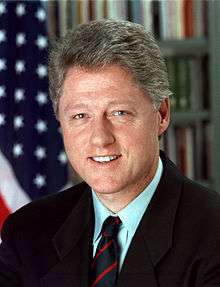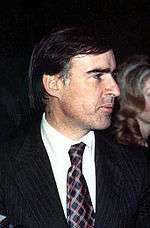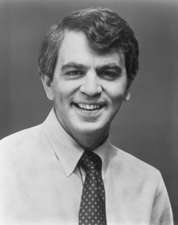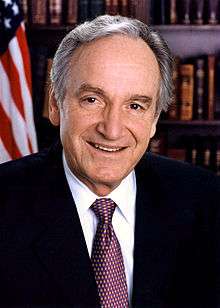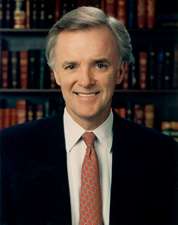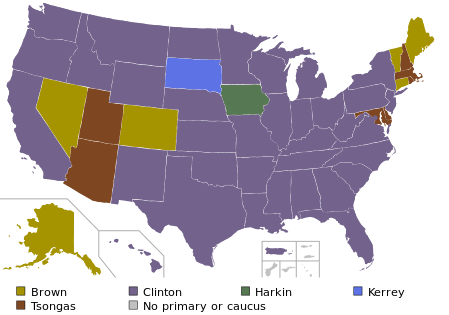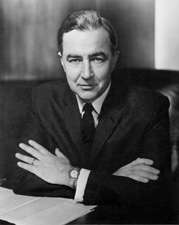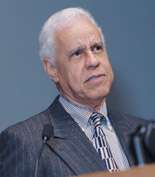Democratic Party presidential primaries, 1992
| | ||||||||||||||||||||||||||||||||||||||||||||||||||||||||||||
| ||||||||||||||||||||||||||||||||||||||||||||||||||||||||||||
| ||||||||||||||||||||||||||||||||||||||||||||||||||||||||||||
|
| ||||||||||||||||||||||||||||||||||||||||||||||||||||||||||||
| ||||||||||||||||||||||||||||||||||||||||||||||||||||||||||||
The 1992 Democratic presidential primaries were the selection process by which voters of the Democratic Party chose its nominee for President of the United States in the 1992 U.S. presidential election. Arkansas Governor Bill Clinton was selected as the nominee through a series of primary elections and caucuses culminating in the 1992 Democratic National Convention held from July 13 to July 16, 1992, in New York City.
Candidates
During the aftermath of the Gulf War, President George H. W. Bush's approval ratings were extremely high. During one point after the successful performance by U.S forces in Kuwait, President Bush's approval ratings were 89%.[1] As a result, several high-profile candidates such as Mario Cuomo refused to seek the Democratic Nomination for President. Senator (later Vice-President) Al Gore refused to seek the nomination due to the fact his son was struck by a car and was undergoing extensive surgery as well as physical therapy.[2]
The Democrats lacked a high-profile viable candidate to face an incumbent Republican president. Still, several candidates such as Bill Clinton, Paul Tsongas and Jerry Brown chose to run.
Candidates:
- Former Mayor Larry Agran of Irvine, California
- Former Governor Jerry Brown of California
- Governor Bill Clinton of Arkansas
- Senator Bob Kerrey of Nebraska
- Senator Tom Harkin of Iowa
- Former Senator Paul Tsongas of Massachusetts
- Governor Douglas Wilder of Virginia
- Filmmaker and activist Tom Laughlin
- Former Senator Eugene McCarthy of Minnesota
Nominee
Withdrew during convention
Withdrew during primaries
Withdrew before primaries
Primary race
Clinton, a Southerner with experience governing a more conservative state, positioned himself as a centrist New Democrat. He prepared for a run in 1992 amidst a crowded field seeking to beat the incumbent President George H. W. Bush. In the aftermath of the Persian Gulf War, Bush seemed unbeatable but an economic recession -- which ultimately proved to be small by historical standards -- spurred the Democrats on. Tom Harkin won his native Iowa without much surprise. Clinton, meanwhile, was still a relatively unknown national candidate before the primary season when a woman named Gennifer Flowers appeared in the press to reveal allegations of an affair. Clinton sought damage control by appearing on 60 Minutes with his wife, Hillary Clinton, for an interview with Steve Kroft. Paul Tsongas of Massachusetts won the primary in neighboring New Hampshire but Clinton's second-place finish – strengthened by Clinton's speech labeling himself "The Comeback Kid" – re-energized his campaign. Clinton swept nearly all of the Southern Super Tuesday primaries, making him the solid front runner. Jerry Brown, however, began to run a surprising insurgent campaign, particularly through use of a 1-800 number to receive grassroots funding. Brown "seemed to be the most left-wing and right-wing man in the field. [He] called for term limits, a flat tax, and the abolition of the Department of Education."[3] Brown scored surprising wins in Connecticut and Colorado and seemed poised to overtake Clinton.
On March 17, Tsongas left the race when he decisively lost both the Illinois and Michigan primaries to Clinton, with Brown as a distant third. Exactly one week later, Brown eked out a narrow win in the bitterly fought Connecticut primary. As the press focused on the primaries in New York and Wisconsin, which were both to be held on the same day, Brown, who had taken the lead in polls in both states, made a serious gaffe: he announced to an audience of various leaders of New York City's Jewish community that, if nominated, he would consider the Reverend Jesse Jackson as a vice presidential candidate. Jackson was still a controversial figure in that community and Brown's polling numbers suffered. On April 7, he lost narrowly to Bill Clinton in Wisconsin (37-34), and dramatically in New York (41-26). In addition, his "willingness to break with liberal orthodoxy on taxes led to denunciations from the party regulars, but by the end of the race he had been embraced by much of the Left."[3]
Although Brown continued to campaign in a number of states, he won no further primaries. Despite this, he still had a sizable number of delegates, and a big win in his home state of California would have deprived Clinton of sufficient support to win the nomination. After nearly a month of intense campaigning and multiple debates between the two candidates, Clinton managed to defeat Brown in the California primary by a margin of 47% to 40%
Statewide contest by winner
Results by state
| Bill Clinton | Jerry Brown | Paul Tsongas | Bob Kerrey | Tom Harkin | Larry Agran | Uncommitted | Charles Woods | Eugene McCarthy | Lyndon LaRouche | ||
|---|---|---|---|---|---|---|---|---|---|---|---|
| February 10 | Iowa Caucus (49 of 49 Delegates) |
2.81% | 1.60% | 4.11% | 2.41% | 76.55% (49-Delegates) |
- | 11.92% | - | - | - |
| February 18 | New Hampshire (18 of 18 Delegates) |
24.78% (9-Delegates) |
8.15% | 33.20% (9-Delegates) |
11.08% | 10.18% | 0.20% | - | 1.71% | 0.13% | 0.07% |
| February 23 | Maine Caucus (23 of 23 Delegates) |
15.13% | 30.77% | 29.31% | 3.01% | 4.99% | - | 16.65% | 0.14% | - | 0.74% |
| February 25 | South Dakota (15 of 15 Delegates) |
19.10% | 3.86% | 9.62% | 40.12% | 25.23% | 1.11% | - | - | - | - |
| March 3 | Colorado (47 of 47 Delegates) |
26.90% | 28.82% | 25.61% | 12.34% | 2.45% | 0.28% | 2.24% | 0.44% | 0.20% | 0.14% |
| March 3 | Georgia (76 of 76 Delegates) |
57.17% | 8.10% | 24.01% | 4.85% | 2.09% | - | 3.80% | - | - | - |
| March 3 | Idaho Caucus (18 of 18 Delegates) |
11.56% | 4.57% | 28.76% | - | 29.57% | - | 17.47% | - | - | - |
| March 3 | Maryland (67 of 67 Delegates) |
35.76% | 8.75% | 43.40% | 5.09% | 6.20% | - | - | - | - | 0.80% |
| March 3 | Minnesota Caucus (78 of 78 Delegates) |
- | - | 19.2% | - | 26.7% | - | - | - | - | - |
| March 3 | Utah Caucus (23 of 23 Delegates) |
18.24% | 28.39% | 33.77% | 10.58% | 4.01% | 0.18% | 2.30% | 0.48% | - | - |
| March 3 | Washington Caucus (71 of 71 Delegates) |
13.82% | 19.32% | 32.01% | 6.14% | 7.52% | 0.79% | 20.40% | - | - | - |
| March 7 | Arizona Caucus (41 of 41 Delegates) |
29.20% | 27.50% | 34.40% | - | 7.60% | - | 1.30% | - | - | - |
| March 7 | South Carolina (43 of 43 Delegates) |
62.90% | 5.98% | 18.33% | 0.49% | 6.58% | - | 3.13% | 0.73% | - | 0.18% |
| March 7 | Wyoming Caucus (13 of 13 Delegates) |
28.57% | 23.08% | 11.72% | - | 14.29% | - | 22.34% | - | - | - |
| March 8 | Nevada Caucus (17 of 17 Delegates) |
26.47% | 34.83% | 19.69% | 0.97% | 0.45% | - | 17.60% | - | - | - |
| March 10 | Florida (148 of 148 Delegates) |
50.79% | 12.19% | 34.75% | 1.06% | 1.22% | - | - | - | - | - |
| March 10 | Hawaii Caucus (14 of 14 Delegates) |
51.49% | 13.60% | 14.30% | 0.40% | 12.71% | - | 7.50% | - | - | - |
| March 10 | Louisiana (60 of 60 Delegates) |
69.46% | 6.63% | 11.06% | 0.78% | 1.05% | 0.91% | - | 2.34% | 3.94% | 0.80% |
| March 10 | Massachusetts (94 of 94 Delegates) |
10.95% | 14.60% | 66.38% | 0.68% | 0.48% | 0.28% | 1.54% | - | 0.39% | 0.27% |
| March 10 | Mississippi (39 of 39 Delegates) |
73.11% | 9.61% | 8.12% | 0.87% | 1.31% | - | 6.16% | - | - | 0.73% |
| March 10 | Missouri (77 of 77 Delegates) |
45.10% | 5.70% | 10.20% | - | - | - | 39.00% | - | - | - |
| March 10 | Oklahoma (45 of 45 Delegates) |
70.47% | 16.69% | - | 3.20% | 3.40% | - | - | 4.04% | - | 1.56% |
| March 10 | Texas (0 of 0 Delegates) |
65.56% | 8.02% | 19.23% | 1.37% | 1.32% | - | - | 2.03% | - | 0.82% |
| March 17 | Illinois (164 of 164 Delegates) |
51.65% | 14.65% | 25.79% | 0.73% | 2.04% | 0.22% | 4.50% | - | - | 0.44% |
| March 17 | Michigan (131 of 131 Delegates) |
50.73% | 16.56% | 25.84% | 0.55% | 1.07% | - | 4.75% | - | - | 0.35% |
| March 19 | North Dakota Caucus (14 of 14 Delegates) |
47.08% | 7.68% | 10.54% | 1.23% | 6.96% | - | 26.51% | - | - | - |
| March 24 | Connecticut (53 of 53 Delegates) |
35.64% | 37.24% | 19.53% | 0.68% | 1.11% | 1.55% | 3.14% | - | 0.60% | 0.52% |
| March 31 | Vermont Caucus (14 of 14 Delegates) |
17.20% | 47.40% | 9.68% | - | - | - | 25.72% | - | - | - |
| April 2 | Alaska Caucus (13 of 13 Delegates) |
30.91% | 33.09% | 1.27% | - | - | - | 34.73% | - | - | - |
| April 5 | Puerto Rico (51 of 51 Delegates) |
95.86% | 1.42% | 0.09% | 1.43% | 0.05% | 0.03% | 0.38% | 0.12% | - | 0.04% |
| April 7 | Kansas (36 of 36 Delegates) |
51.26% | 12.99% | 15.23% | 1.38% | 0.59% | 0.09% | 13.83% | 0.70% | - | 0.39% |
| April 7 | Minnesota (0 of 78 Delegates) |
31.14% | 30.60% | 21.35% | 0.58% | 2.00% | 0.51% | 5.57% | 0.49% | 1.81% | 0.26% |
| April 7 | New York (244 of 244 Delegates) |
40.92% | 26.23% | 28.61% | 1.11% | 1.15% | 1.07% | - | - | 0.93% | - |
| April 7 | Wisconsin (82 of 82 Delegates) |
37.19% | 34.46% | 21.83% | 0.39% | 0.70% | 0.41% | 2.01% | - | 0.85% | 0.40% |
| April 11 | Virginia Caucus (78 of 78 Delegates) |
52.00% | 12.00% | - | - | - | - | 36.00% | - | - | - |
| April 28 | Pennsylvania (169 of 169 Delegates) |
56.48% | 25.72% | 12.76% | 1.64% | 1.66% | - | - | - | - | 1.70% |
| May 5 | Delaware Caucus (14 of 14 Delegates) |
20.78% | 19.50% | 30.16% | - | - | - | 29.57% | - | - | - |
| May 5 | Indiana (77 of 77 Delegates) |
63.31% | 21.47% | 12.21% | 3.01% | - | - | - | - | - | - |
| May 5 | North Carolina (84 of 84 Delegates) |
54.10% | 10.40% | 8.32% | 0.90% | 0.85% | - | 15.42% | - | - | - |
| May 5 | Washington D.C. (17 of 17 Delegates) |
73.87% | 7.21% | 10.41% | - | - | - | 8.51% | - | - | - |
| May 12 | Nebraska (25 of 25 Delegates) |
45.53% | 21.03% | 7.11% | - | 2.82% | 0.19% | 16.41% | 0.32% | 1.01% | 0.76% |
| May 12 | West Virginia (31 of 31 Delegates) |
74.24% | 11.90% | 6.93% | 1.03% | 0.90% | - | - | 0.49% | - | 1.02% |
| May 19 | Oregon (47 of 47 Delegates) |
45.10% | 31.18% | 10.48% | - | - | 0.47% | - | 0.54% | 1.90% | 0.87% |
| May 19 | Washington (0 of 71 Delegates) |
42.01% | 23.05% | 12.83% | 1.01% | 1.26% | - | - | - | - | 0.72% |
| May 26 | Idaho (0 of 18 Delegates) |
48.99% | 16.71% | - | - | - | 1.58% | 29.08% | - | - | 3.65% |
| May 26 | Kentucky (52 of 52 Delegates) |
56.08% | 8.29% | 4.88% | 0.88% | 1.93% | - | 27.95% | - | - | - |
| May 27 | Arkansas (36 of 36 Delegates) |
68.05% | 11.02% | - | - | - | - | 18.03% | - | - | 2.90% |
| June 2 | Alabama (55 of 55 Delegates) |
68.22% | 6.72% | - | - | - | - | 20.15% | 3.38% | - | 1.45% |
| June 2 | California (348 of 348 Delegates) |
47.47% | 40.18% | 7.42% | 1.19% | - | 0.87% | - | - | 2.12% | 0.77% |
| June 2 | Montana (16 of 16 Delegates) |
46.81% | 18.48% | 10.74% | - | - | - | 23.98% | - | - | - |
| June 2 | New Jersey (105 of 105 Delegates) |
63.26% | 19.76% | 11.15% | - | - | - | - | - | - | 1.93% |
| June 2 | New Mexico (25 of 25 Delegates) |
52.87% | 16.92% | 6.24% | - | 1.78% | 1.42% | 19.44% | - | - | 1.33% |
| June 2 | Ohio (151 of 151 Delegates) |
61.24% | 18.94% | 10.63% | 2.20% | 2.44% | - | - | - | - | 1.67% |
| June 9 | North Dakota (0 of 14 Delegates) |
14.52% | - | - | - | - | - | - | 20.26% | - | 21.36% |
| Legend: | 1st place (popular vote) |
2nd place (popular vote) |
3rd place (popular vote) |
|---|
The convention
The convention met in New York City, and the official tally was:
- Bill Clinton 3,372
- Jerry Brown 596
- Paul Tsongas 209
- Penn. Gov. Robert P. Casey 10
- Rep. Pat Schroeder 8
- Larry Agran 3
- Ron Daniels 1
- Al Gore 1
- Joe Simonetta 1
Clinton chose U.S. Senator Albert A. Gore Jr. (D-Tennessee) to be his running mate on July 9, 1992. Choosing Gore, who is from Clinton's neighboring state of Tennessee, went against the popular strategy of balancing a Southern candidate with a Northern partner. Gore did serve to balance the ticket in other ways, as he was perceived as strong on foreign policy and environmental issues, while Clinton was not.[4] Also, Gore's similarities to Clinton allowed him to really push some of his key campaign themes, such as centrism and generational change.[5]
Before Gore's selection, other politicians were mentioned as a possible running-mate, e.g. Bob Kerrey, Dick Gephardt, Mario Cuomo, Indiana Representative Lee H. Hamilton, Pennsylvania Senator Harris Wofford, Florida Senator Bob Graham, and Massachusetts Senator John Kerry.
The Democratic Convention in New York City was essentially a solidification of the party around Clinton and Gore, though there was controversy over whether Jerry Brown would be allowed to speak. Brown did speak at the convention by seconding his own nomination.
Another additional controversy concerned Pennsylvania Governor Bob Casey, who sought a speaking slot at the convention but was not granted one. Casey complained that it was because of his outspoken pro-life views: he had warned the platform committee that Democrats were committing political suicide because of their support for abortion.[6] Clinton supporters have said that Casey was not allowed to speak because he had not endorsed the ticket.[7]
Popular vote results
Total popular vote number in primaries:[8]
- Bill Clinton - 10,482,411 (52.01%)
- Jerry Brown - 4,071,232 (20.20%)
- Paul Tsongas - 3,656,010 (18.14%)
- Unpledged - 750,873 (3.73%)
- Bob Kerrey - 318,457 (1.58%)
- Tom Harkin - 280,304 (1.39%)
- Lyndon LaRouche - 154,599 (0.77%)
- Eugene McCarthy - 108,678 (0.54%)
- Charles Woods - 88,948 (0.44%)
- Larry Agran - 58,611 (0.29%)
- Ross Perot - 54,755 (0.27%)
- Ralph Nader - 35,935 (0.18%)
- Louis Stokes - 29,983 (0.15%)
- Angus Wheeler McDonald - 9,900 (0.05%)
- J. Louis McAlpine - 7,911 (0.04%)
- George W. Benns - 7,887 (0.04%)
- Rufus T. Higginbotham - 7,705 (0.04%)
- Tom Howard Hawks - 7,434 (0.04%)
- Stephen Bruke - 5,261 (0.03%)
- Tom Laughlin - 5,202 (0.03%)
- Tom Shiekman - 4,965 (0.03%)
- Jeffrey F. Marsh - 2,445 (0.01%)
- George Ballard - 2,067 (0.01%)
- Ray Rollinson - 1,206 (0.01%)
- Leonora Fulani - 402 (0.00%)
- Douglas Wilder - 240 (0.00%)
Convention tallies
For President:[9]
- Bill Clinton - 3,372 (80.27%)
- Jerry Brown - 596 (14.19%)
- Paul Tsongas - 209 (4.98%)
- Robert P. Casey - 10 (0.24%)
- Patricia Schroeder - 8 (0.19%)
- Larry Agran - 3 (0.07%)
- Ron Daniels - 1 (0.02%)
- Al Gore - 1 (0.02%)
- Joe Simonetta 1 (0.02%)
Vice presidential nomination
Clinton selected Tennessee Senator and 1988 candidate Al Gore to be his running-mate. Among others confirmed possible V.P. nominees, who were finalists of Clinton's selection were:
- Jay Rockefeller, U.S. senator from West Virginia
- Bob Graham, U.S. senator from Florida
- Lee H. Hamilton U.S. representative from Indiana.[10]
- Tom Harkin, U.S. senator from Iowa
- Bob Kerrey, U.S. senator from Nebraska
- George Mitchell, U.S. senator from Maine
- Paul Tsongas, former U.S. senator from Massachusetts
- Doug Wilder, Governor of Virginia
- Harris Wofford, U.S. senator from Pennsylvania
Clinton's list of finalists did not include Senator Bill Bradley of New Jersey and Governor of New York Mario Cuomo, who publicly disavowed interest in Vice Presidency.[10]
Convention tally for Vice President
- Al Gore - was nominated by acclamation on a voice vote.
In popular media
The story of the race was covered in the documentary film The War Room and fictionalized into the novel and film Primary Colors.
See also
Bibliography
- Clinton, Bill (2005). My Life. Vintage. ISBN 1-4000-3003-X
References
- ↑ Kagay, Michael R. (May 22, 1991). "History Suggests Bush's Popularity will eventually ebb". The New York Times. Retrieved May 1, 2010.
- ↑ "Al Gore's son buster for drugs in hybrid". Reuters. July 5, 2007.
- 1 2 Walker, Jesse (2009-11-01) Five Faces of Jerry Brown, The American Conservative
- ↑ Ifill, Gwen (1992-07-10). "Clinton Selects Senator Gore Of Tennessee As Running Mate". The New York Times. Retrieved 2008-03-27.
- ↑ Al Gore from the United States Senate
- ↑ The Atlanta Journal and The Atlanta Constitution May 19, 1992 Page: A/8
- ↑ "The myth of Bob Casey's 1992 non-speech". Brendan Nyhan. 2008-08-07. Retrieved 2016-08-03.
- ↑ "US President - D Primaries Race - Feb 01, 1992". Our Campaigns. Retrieved 2016-08-03.
- ↑ "US President - D Convention Race - Jul 13, 1992". Our Campaigns. Retrieved 2016-08-03.
- 1 2 Ifill, Gwen (July 10, 1992). "THE 1992 CAMPAIGN: Democrats; CLINTON SELECTS SENATOR GORE OF TENNESSEE AS RUNNING MATE". The New York Times. Retrieved May 1, 2010.
